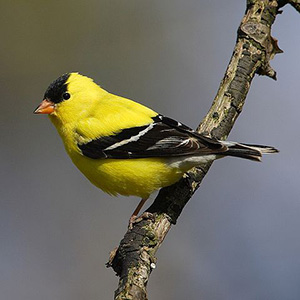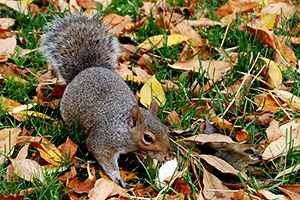Rocky vs. Tweety: A True Survival Story
Rocky vs. Tweety: A True Survival Story
By Bill Willis
March, 2016

One blustery morning in December, I received an email from Erin Knight of the NIEHS Library, alerting me that she’d just witnessed a gray squirrel feasting on the feathered remains of a bird. The squirrel looked at her; she looked at it. Then the creature darted into the brush, clutching the last of its bounty. The sight unnerved Erin, as it was apparently quite gruesome, and thus she wanted to know if such squirrel-on-bird atrocities were normal.
The Answer: Quite, actually.
As many bird watchers will attest, squirrels and bird feeders don’t go together. If you have nesting birds near feeders, visiting squirrels can rob eggs and remove chicks. Even in the bluebird program, squirrels have enlarged the nest box opening, sometimes cutting through metal guards to reach the would-be snacks inside.
Is this to say that squirrels prefer meat to veggies on the menu? Not at all.

Acorns make up the majority of the squirrel’s diet, especially in the late summer and winter months. To insure a good supply, acorns are hidden in holes and crevices, or buried in the soft earth of flowerbeds.
In North Carolina, the gray squirrel stays active year round so an easily accessible food source is always stored within reach. They also survive on buds, mushrooms, vegetables, and fruits — none of which surprises the gardeners reading this column.
Nevertheless, squirrels (and also chipmunks) do possess carnivorous tendencies, evidenced by “The Great Birdnapping” outside of Rall building. Both will eat their own kind, plus the occasional rodent, snake, vole, frog, or salamander when given the chance.
Conclusion: No matter how much it pains us to see Tweety on the losing end of nature’s food chain we must accept that while squirrels and chipmunks are fantastic gatherers, they’re fantastic hunters, as well.
(Bill Willis is a biologist with the NIEHS Reproductive and Developmental Biology Laboratory.)



